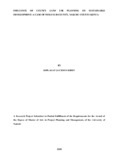| dc.description.abstract | Devolution and decentralization of government function has been exhibited world over for purpose of curing the historical ills of centralized control of government power and resources.The Kenyan governments has in the past made deliberate efforts in ensuring that land use planning reaches the lower levels with the aim of achieving balanced growth and development in the whole country. According to UN –Habitat, 2013.It is estimated that the population of Africans in intermediate cities will increase to 47.2 million by 2025 thus there is need to prepare land use plans that will cater for the needs of the present generations without compromising those of the future considering thatLand available continues to remain static and continue to remain as the main source of livelihood to many people in Molo Sub-County and all socio-economic activities depend largely on land. Thus, rights of land ownership and balanced distribution of various land use including agricultural, residential, commercial, educational, recreational, industrial public utilities and public purposes are critical in influencing growth in all sectors and is crucial to the realisation of the dreams and aspiration of the Kenyan people. The Fourth Schedule delineates the functions of the national and county governments. A total of 14 functions have been devolved to the counties that includes county planning among others and the legal framework upon which land use planning within county governments is anchored are Five laws which include: Urban Areas and Cities Act, 2011; The County Governments Act, 2012; land Act 2012, The Intergovernmental Relations Act, 2012 and The Public Finance Management Act, 2012.The purpose of this studywas to investigate the influence of Devolution on sustainable land use planning within Molo Sub CountyNakuru County in the first Era of devolution after the promulgation of the Kenyan Constitution 2010, the study covered the first era of devolution(2013-2017). The study was be guided by four objectives which were; to determine the impact of devolution on stakeholder participation in sustainable land use planning, to establish the influence of devolution on efficiency in service delivery in the department of physical planning in devolved units of governance, to evaluate the influence of technology in spatial data management and planning andto establish challenges faced at the sub-county and make recommendations on how devolved units of governance can enhance sustainable land use planning. This study was be based on the Stakeholder theory propagated by freeman in 1984 where he urged that to ensure that a project is successful and sustainable, project implementers have to ensure that the interests of the varied groups are taken care of. The target population was the120, 000 households drawn from the four wards in the sub county that include Marioshoni, Turi, Elburgon and Molo town. Simple random sampling and purposive sampling was applied for the study with a sample size being 120 households. The study used questionnaires, interview guide and Focused Group Discussions (FGD) for data collection. The data collected was analysed using descriptive statistics that will utilize the frequency distributions, percentages, averages or means and presented using frequency distribution tables. The study found out that devolved functions had a positive influence on sustainable land use plans within Molo sub-county.The findings from the study indicate that Decentralization of County Land use planning has to a small extent enabled the realisation of sustainable land use planning in terms of improved service delivery and equity in distribution of various land uses and this has enabled achievement of four objectives of devolution that include enhancing balanced growth, community participation, integrity and transparency in resource distribution and allocation that enables sustainable development in land use planning within Molo Sub-county. The study is of great importance to the department of Land and physical planning, the development partners in the built environment, the academic fraternity informing them the extent to which community participation, equity and efficiency in resource allocation impact on sustainable land use planning in Counties. The study has also provided useful information that would be utilised by policy makers in the County assembly in revising the County public participation Bill that is currently being formulated by the County Assembly. The county department of Land Housing and Physical Planning will also benefit from information gathered to address various challenges identified as well as aid in prioritizing areas that require urgent planning | en_US |



